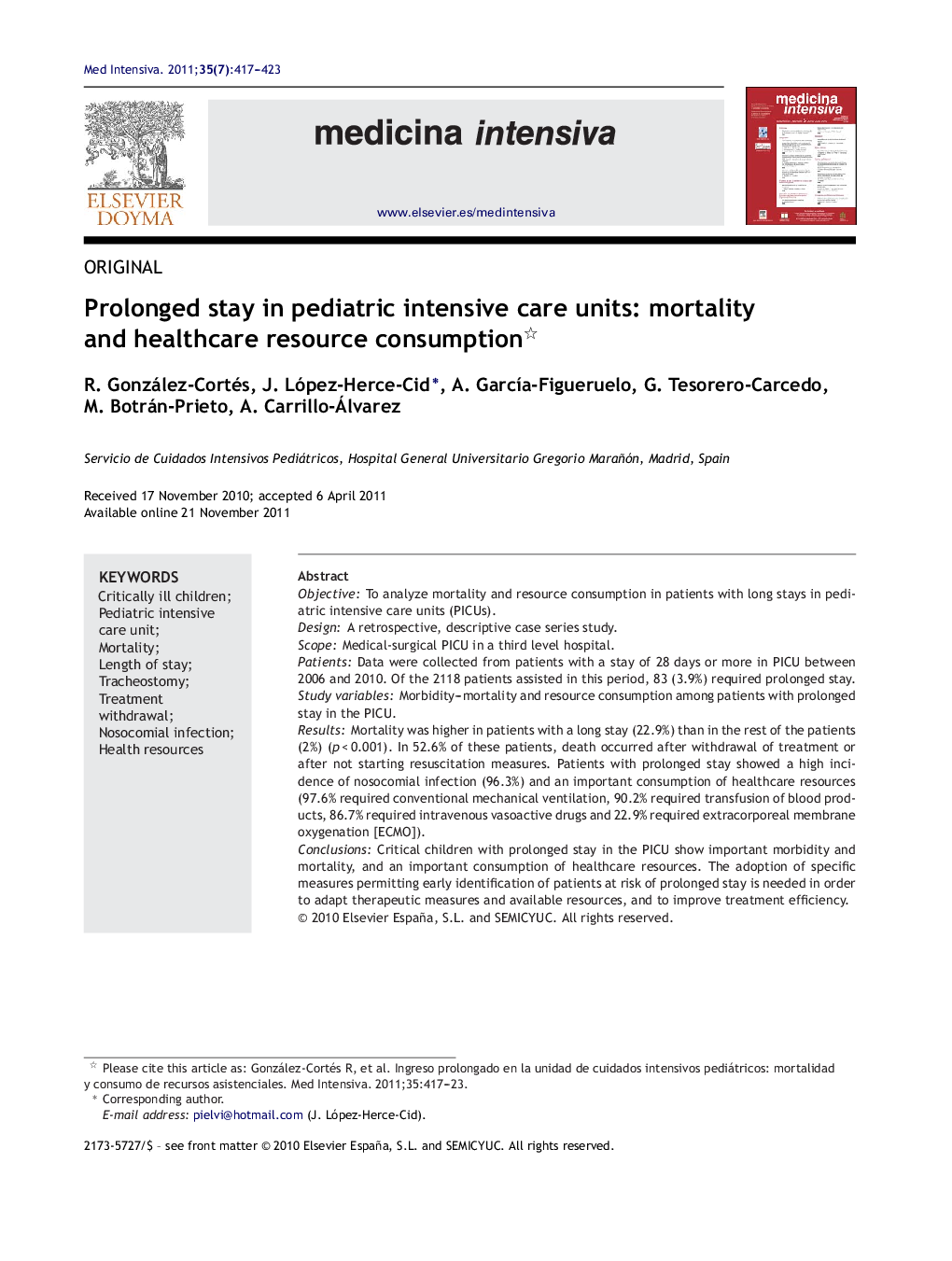| کد مقاله | کد نشریه | سال انتشار | مقاله انگلیسی | نسخه تمام متن |
|---|---|---|---|---|
| 3114285 | 1192509 | 2011 | 7 صفحه PDF | دانلود رایگان |

ObjectiveTo analyze mortality and resource consumption in patients with long stays in pediatric intensive care units (PICUs).DesignA retrospective, descriptive case series study.ScopeMedical-surgical PICU in a third level hospital.PatientsData were collected from patients with a stay of 28 days or more in PICU between 2006 and 2010. Of the 2118 patients assisted in this period, 83 (3.9%) required prolonged stay.Study variablesMorbidity–mortality and resource consumption among patients with prolonged stay in the PICU.ResultsMortality was higher in patients with a long stay (22.9%) than in the rest of the patients (2%) (p < 0.001). In 52.6% of these patients, death occurred after withdrawal of treatment or after not starting resuscitation measures. Patients with prolonged stay showed a high incidence of nosocomial infection (96.3%) and an important consumption of healthcare resources (97.6% required conventional mechanical ventilation, 90.2% required transfusion of blood products, 86.7% required intravenous vasoactive drugs and 22.9% required extracorporeal membrane oxygenation [ECMO]).ConclusionsCritical children with prolonged stay in the PICU show important morbidity and mortality, and an important consumption of healthcare resources. The adoption of specific measures permitting early identification of patients at risk of prolonged stay is needed in order to adapt therapeutic measures and available resources, and to improve treatment efficiency.
ResumenObjetivoAnalizar la mortalidad y el consumo de recursos de los niños con ingreso prolongado en unidades de cuidados intensivos pediátricos (UCIP).DiseñoEstudio descriptivo retrospectivo de una serie de casos.ÁmbitoUCIP médico-quirúrgica de un hospital de tercer nivel.PacientesSe recogieron los datos de los pacientes ingresados durante 28 o más días en la UCIP entre 2006 y 2010. De los 2.118 pacientes ingresados entre 2006 y 2010, 83 (3,9%) requirieron ingreso prolongado.Variables de interésSe analizaron la morbimortalidad y el consumo de recursos por los pacientes con ingreso prolongado.ResultadosLa mortalidad de los pacientes con ingreso prolongado fue mayor (22,9%) que la del resto de los pacientes (2%) (p < 0,001). En un 52,6% de estos pacientes el fallecimiento se produjo tras la limitación del esfuerzo terapéutico o por no iniciar medidas de reanimación. Los pacientes con ingreso prolongado presentaron una elevada incidencia de infección nosocomial (96,3%) y un elevado consumo de los recursos asistenciales (el 97,6% precisó ventilación mecánica; el 90,2%, transfusión de hemoderivados; el 86,7% fármacos vasoactivos intravenosos, y el 22,9%, oxigenación por membrana extracorpórea (ECMO)).ConclusionesLos niños en estado crítico con ingreso prolongado en la UCIP tienen una elevada morbimortalidad y requieren un elevado consumo de recursos asistenciales. Son necesarias medidas específicas que permitan identificar precozmente a los pacientes susceptibles de presentar ingreso prolongado para adecuar las medidas terapéuticas y los recursos disponibles y mejorar la eficiencia del tratamiento.
Journal: Medicina Intensiva (English Edition) - Volume 35, Issue 7, October 2011, Pages 417–423